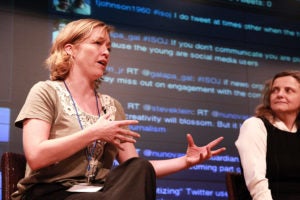April 15, 2011 | Featured, Social Media
Reflections: Social Media and The New Face of Journalism

The use of social media in the realm of journalism was a topic at the 12th Annual ISOJ. One research panel, All About the Tweet and More, got right to that point.
The panel included Cindy Royal and Dale Blasingame of Texas State University, Carrie Brown of the University of Memphis, Marcus Messner of VCU, and Elvira Garcia de Torres of Universidad CEU Cardenal Herrera, Spain. Research topics included Blasingame’s view of Twitter as the new “go-to” for journalists. He showed that Twitter works best for breaking news, but that journalists need to be aware of the risk of inaccurate facts being tweeted due to the demand of speed over accuracy.
This became more of an upfront issue in the news of the shooting of Gabrielle Giffords. NPR tweeted that she had been killed before there was an official announcement.
Blasingame also reported the growing use of Twitter across the state of Texas, and that most news sources are starting to use the social media outlet as ways to add value to news stories and news gathering.
Brown carried the conversation of social media over to diversity. She reported that the minorities she interviewed used Twitter on average more than Caucasians.
He study also showed that as a group of young adults, college students are using the social network more for casual conversation and to keep up with their favorite celebrities.
When it came to the use of journalism and Twitter amongst college students, most didn’t use their accounts for that reason. Hash tags would create room for conversation and debate, but that was only in instances where Twitter allowed for the users Brown interviewed to form a community.
Keeping on the idea of sharing news stories via tweeting, Messner shared how social networks helped the process of promoting news content and breaking news.
Twitter is listed as the 7th most popular website in the country, and getting information out to the audience is difficult amongst the site’s 200 million users, he said.
The use of hyperlinks in tweets also helps with the spreading of information, and allows for future research.
Garcia de Torres ended the panel with how social media outlets like Twitter and Facebook allowed for the development of social markets and allowed for a more active search of info.
The panel concluded with the audience engaging in the idea of tweeting headlines and hyperlinks, versus “tweet-dumping”.
“Tweet-dumping” occurs when stories are simply re-posted with no extra reporting or content. The use of headlines in tweets was deemed more tolerable and still connects readers to stories.
ISOJ 2011: “All About the Tweets and More” Q&A (Part 1), from Knight Center on vimeo.

